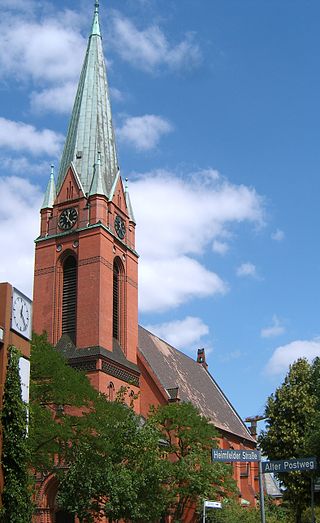
Eimsbüttel is one of the seven boroughs (Bezirke) of Hamburg, Germany. In 2020, the borough had a population of 269,118.

Wilhelmsburg is a quarter (Stadtteil) of Hamburg, Germany within the borough (Bezirk) of Hamburg-Mitte. It is situated on several islands between the Northern and Southern branches of the Elbe river, together with the other quarters of Steinwerder, Veddel and Kleiner Grasbrook. The latter almost exclusively consists of facilities of the port of Hamburg. In 2020 the population was 53,064.

Finkenwerder is a quarter of Hamburg, Germany in the borough Hamburg-Mitte. It is the location of the Hamburg Airbus plant and its airport. In 2016 the population was 11,668.

is a rural quarter located in the borough Harburg of Hamburg, Germany near the Lower Saxony border. The quarter is well known for its quality of fruit and unique houses, many of which prove to be popular attractions for tourists passing through, it belongs to the Altes Land region and is quite known for the cherry and apple tree blossom. In 2020 the population was 4,883.

[] is a quarter of Hamburg, Germany, and belongs to the borough Harburg. The quarter consists of the old settlements Neugraben and Fischbek, and the more recently constructed area Neuwiedenthal.
The city of Hamburg in Germany is made up of seven boroughs and subdivided into 104 quarters. Most of the quarters were former independent settlements. The areal organisation is regulated by the constitution of Hamburg and several laws. The subdivision into boroughs and quarters was last modified in March 2008.

Hamburg-Mitte is one of the seven boroughs of Hamburg, Germany, covering most of the city's urban center. The quarters of Hamburg-Altstadt and Neustadt cover much of the city's historic core. In 2020 the population was 301,231.

Cranz is a quarter in the Harburg borough of Hamburg, Germany. It is on the left bank of the Elbe river and one of the 104 quarters of Hamburg. In 2020 the population was 843.

Altenwerder is a quarter in the Harburg borough of the Free and Hanseatic city of Hamburg in northern Germany. The former village on an Elbe island became a port expansion area in the 1960s. In the 1970s the city of Hamburg announced the formal dispossession of all property to build the Container Terminal Altenwerder. Only the Altenwerder church remains from the old buildings. The terminal started its operation in 2003. Today, Altenwerder is a quarter almost without population. In 2023 the population was 4.

Altengamme located in the Bergedorf borough of the Free and Hanseatic City of Hamburg in northern Germany, is a rural quarter on the right bank of the Elbe river. Altengamme is the most eastern part of Hamburg. In 2023 the population was 2,345.

Kleiner Grasbrook is a quarter of Hamburg, Germany within the borough of Hamburg-Mitte. It is situated on the eponymous island between the Northern and Southern branches of the Elbe river, together with the other quarters of Steinwerder, Veddel and Wilhelmsburg. It almost exclusively consists of facilities of the port of Hamburg. The four quarters are technically all islands of their own, as they are all separated by their own dams. In 2020 the population was 1,120.

The Harburg Hills are a low ridge in the northeastern part of the German state of Lower Saxony and the southern part of the city state of Hamburg. They are up to 155 metres (509 ft) high.

Harburg is a quarter (Stadtteil) in the Harburg borough (Bezirk) of Hamburg, Germany. It used to be the capital of the Harburg district in Lower Saxony. In 2020, the population was 25,979.

Francop is a quarter in the Harburg borough of the Free and Hanseatic city of Hamburg in northern Germany. In 2020 the population was 711.

The Harburg S-Bahn line is a railway line in southern Hamburg, Germany. It starts at Hamburg Hauptbahnhof and runs via Harburg to Stade. It mostly runs parallel with the line to Hanover and the Lower Elbe line and is now part of the Hamburg S-Bahn lines S3 and S31.

Eißendorf is a quarter of Hamburg, Germany, in the borough of Harburg. More than 24,300 inhabitants live in an area of 8.4 km2.

is a quarter of Hamburg, Germany, in the borough of Harburg on its southeastern boundaries adjacent to Harburg district in Niedersachsen. It is one of the smallest quarters of Hamburg. 133 inhabitants lived in an area of 1.97 km2 in 2016.
is a quarter of Hamburg, Germany, in the borough of Harburg. It is located in the east of the borough below the Elbe river. In 2020 the population was 1,794.

Hausbruch is a quarter of Hamburg, Germany in the Harburg borough. It was first mentioned in 1553. The large housing estate of Neuwiedenthal is located in the quarter.

Heimfeld is a quarter of Hamburg, Germany in the Harburg borough.

























